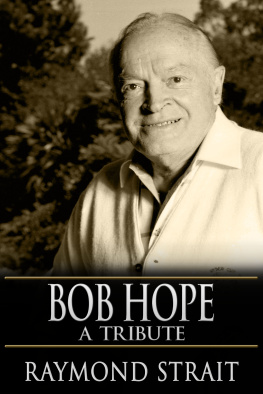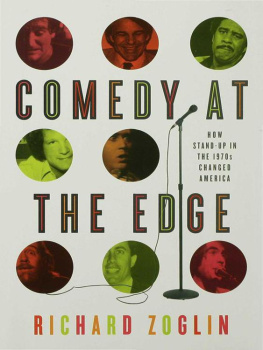Thank you for downloading this Simon & Schuster eBook.
Join our mailing list and get updates on new releases, deals, bonus content and other great books from Simon & Schuster.
C LICK H ERE T O S IGN U P
or visit us online to sign up at
eBookNews.SimonandSchuster.com
We hope you enjoyed reading this Simon & Schuster eBook.
Join our mailing list and get updates on new releases, deals, bonus content and other great books from Simon & Schuster.
C LICK H ERE T O S IGN U P
or visit us online to sign up at
eBookNews.SimonandSchuster.com
ALSO BY RICHARD ZOGLIN
Comedy at the Edge: How Stand-Up in the 1970s Changed America

Simon & Schuster
1230 Avenue of the Americas
New York, NY 10020
www.SimonandSchuster.com
Copyright 2014 by Richard Zoglin
All rights reserved, including the right to reproduce this book or portions thereof in any form whatsoever. For information address Simon & Schuster Subsidiary Rights Department, 1230 Avenue of the Americas, New York, NY 10020.
First Simon & Schuster hardcover edition November 2014
SIMON & SCHUSTER and colophon are registered trademarks of Simon & Schuster, Inc.
The Simon & Schuster Speakers Bureau can bring authors to your live event. For more information or to book an event contact the Simon & Schuster Speakers Bureau at 1-866-248-3049 or visit our website at www.simonspeakers.com.
Interior design by Ruth Lee-Mui
Jacket design by Michael Accordino
Jacket photograph Philippe Halsman/Magnum Photos
Library of Congress Cataloging-in-Publication Data
Zoglin, Richard.
Hope : entertainer of the century / Richard Zoglin. First Simon & Schuster hardcover edition.
pages cm
Includes bibliographical references and index.
1. Hope, Bob, 19032003. 2. ComediansUnited StatesBiography. I. Title.
PN2287.H63Z85 2014
792.702'8092dc23
[B]2014014371
ISBN 978-1-4391-4027-7
ISBN 978-1-4391-4858-7 (ebook)
For Charla
Contents
INTRODUCTION
On a balmy October morning in 2010, one hundred people were gathered on a dock in Battery Park at the foot of Manhattan Island. They were a well-dressed groupthe men in jackets and ties, the women in business suits. Many were quite old and needed help climbing into the boat that had been chartered to ferry them across New York Harbor to Ellis Island. Once there, they made their way to the second floor of the cavernous Immigration Museum building, where rows of chairs had been set up in a long, book-lined room, which was about to be dedicated as the Bob Hope Memorial Library.
Linda Hope, the late comedians seventy-one-year-old daughter, stepped to the microphone to emcee the ceremony. She introduced the smattering of celebrities on handactress Arlene Dahl, baseball legend Yogi Berra, two US congressmenand several clip reels highlighting Bobs life and career: his childhood years in England, where he was born in 1903, and Cleveland, Ohio, where he and his family emigrated when he was four and a half; scenes from his movies and TV shows; excerpts from his tours to entertain US troops around the globe. His granddaughter, Miranda, accompanying herself on guitar, sang a folk ballad called Immigrant Eyes. Dick Cavett popped up from the audience to tell a couple of impromptu stories about Hope, whom he had befriended in the comedians later years. Michael Feinstein, the cabaret singer and musical archivist, closed the event with a wistful solo rendition of Bobs theme song, Thanks for the Memory.
It was another chapter in what has surely been the most determined campaign of legacy building in Hollywood history. A few months before the Ellis Island ceremony, Hopes family and friends gathered in Washington, DC, to inaugurate a new Hope-centric exhibit on political humor at the Library of Congress, where the comedians voluminous letters and papers are stored. A year earlier, the Hope legacy tour made a stop on the deck of the USS Midway in San Diego Harbor to mark the introduction of a postage stamp bearing Hopes likeness. Memorials to Hope have proliferated across the American landscape. You can walk down streets named for Bob Hope in El Paso, Texas, Miami, Florida, and Branson, Missouri; cross the Cuyahoga River on the Hope Memorial Bridge in Cleveland, Ohio; and bypass the congestion at Los Angeles International by flying into the Bob Hope Airport in Burbank, California. Hopes name is memorialized on hospitals, theaters, chapels, schools, performing arts centers, and American Legion posts from Miami to Okinawa. The US Air Force named a transport plane for him, and the Navy christened a cargo ship in his honor. Bob Hope Village, in Shalimar, Florida, provides a home for retired members of the Air Force and their surviving spouses. The World Golf Hall of Fame, in St. Augustine, Florida, features an exhibit celebrating Hopes passion for the game, Bob Hope: Shanks for the Memory. A dozen colleges offer scholarships in Hopes name. Another dozen organizations give out awards in his honor, among them the Air Forces annual Spirit of Hope Award and the Bob Hope Humanitarian Award, presented by the Academy of Television Arts & Science.
His punchy, two-syllable name, so emblematic of the optimistic American spirit; the unmistakable profile, with its jutting chin and famously ski-slope-shaped nose; the indelible images of Hope performing for throngs of cheering GIs in World War II and Vietnamit was once impossible to imagine a time when the first question that needed to be answered about the most popular comedian in American history would be: Who was Bob Hope, and why did he matter?
By the time he diedon July 27, 2003, two months after his hundredth birthdayHopes reputation was already fading, tarnished, or being actively disparaged. He had, unfortunately, stuck around too long. The comedian of the century, who began his vaudeville career in the 1920s and was still headlining TV specials in the 1990s, continued performing well into his dotage, and a younger generation knew him mainly as a cue-card-reading antique, cracking dated jokes about buxom beauty queens and Gerald Fords golf game. Worlds Last Bob Hope Fan Dies of Old Age, the Onion s fake headline announced a year before his death. Writer Christopher Hitchens expressed the disaffection of many of the baby-boom generation in an online dismissal of Hope just a few days after his passing: To be paralyzingly, painfully, hopelessly unfunny is a serious drawback, even lapse, in a comedian. And the late Bob Hope devoted a fantastically successful and well-remunerated lifetime to showing that a truly unfunny man can make it as a comic. There is a laugh here, but it is on us.
Hope never recovered from the Vietnam years, when his hawkish defense of the war, close ties to President Nixon (who actively courted Hopes help in selling his Vietnam policies to the American people), and the country-club smugness of his gibes about antiwar protesters and long-haired hippies, all made him a political pariah for the peace-and-love generation. His tours to entertain US troops during World War II had made him a national hero. By the turbulent 1960s, he was a court-approved jester, the Establishments comedianhardly a badge of honor in an era when hipper, more subversive comics, from Mort Sahl and Lenny Bruce to George Carlin and Richard Pryor, were showing that stand-up comedy could be a vehicle for personal expression, social criticism, and political protest. Even before Hope became a doddering relic, he had become an anachronism.
Yet the scope of Hopes achievement, viewed from the distance of a few years, is almost unimaginable. By nearly any measure, he was the most popular entertainer of the twentieth century, the only one who achieved successoften No. 1rated successin every major genre of mass entertainment in the modern era: vaudeville, Broadway, movies, radio, television, popular song, and live concerts. He virtually invented stand-up comedy in the form we know it today. His face, voice, and stage mannerisms (the nose, the lopsided smile, the confident, sashaying walk, and the ever-present golf club) made him more recognizable to more people than any other entertainer since Charlie Chaplin. A tireless stage performer who traveled the country and the world for more than half a century doing live shows for audiences in the thousands, he may well have been seen in person by more people than any other human being in history.
Next page







